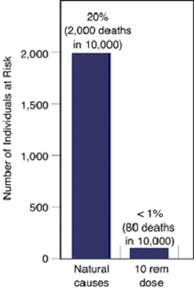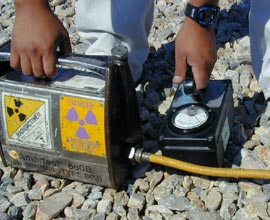Introduction to Radiation Safety


Radiography is an important tool in nondestructive evaluation. The method offers a number of advantages over other NDE methods, but one of its disadvantages is the health risk associated with the radiation. Health effects can occur due to either long-term low level exposure or short-term high level exposure.
 The primary risk from occupational radiation exposure is an increased risk of cancer. The amount of risk depends on the amount of radiation dose received, the time over which the dose is received, and the body parts exposed. Although scientists assume low-level radiation exposure increases one's risk of cancer, medical studies have not demonstrated adverse health effects in individuals exposed to small chronic radiation doses (i.e., up to 10,000 mrem above background). The increased risk of cancer from occupational radiation exposure is small when compared to the normal cancer rate in today's society. The current lifetime risk of dying from all types of cancer in the United States is approximately 20 percent (see Figure). If a person received a radiation dose of 10 rem to the entire body (above background), his or her risk of dying from cancer would increase by one percent.
The primary risk from occupational radiation exposure is an increased risk of cancer. The amount of risk depends on the amount of radiation dose received, the time over which the dose is received, and the body parts exposed. Although scientists assume low-level radiation exposure increases one's risk of cancer, medical studies have not demonstrated adverse health effects in individuals exposed to small chronic radiation doses (i.e., up to 10,000 mrem above background). The increased risk of cancer from occupational radiation exposure is small when compared to the normal cancer rate in today's society. The current lifetime risk of dying from all types of cancer in the United States is approximately 20 percent (see Figure). If a person received a radiation dose of 10 rem to the entire body (above background), his or her risk of dying from cancer would increase by one percent.
Complicating matters further is the fact that Gamma and X-ray radiation are not detectable by the human body. However, the risks can be minimized when the radiation is handled and managed properly. The law requires that individuals receive training in the safe handling and use of radioactive materials and radiation producing devices. Some of the topics this training should cover include:
- Health concerns associated with exposure to radioactive materials or radiation.
- Precautions or procedures to minimize exposure to radiation.
- Purposes and functions of protective devices employed.
- The permit conditions and the applicable portions of the Radiation Safety Manual.
- Worker’s responsibility to promptly report any condition that may lead to or cause a violation of the regulations or cause an unnecessary exposure.
- Actions to take in the event of an emergency.
- Radiation exposure reports that workers have a right to receive.
This material is intended to provide an overview of the fundamental principles and safety regulations as they apply to radiography. It does not in itself satisfy all of the radiation safety training required by law.

